But, as they say, necessity is the mother of invention. Though the past inventions might not compete with the new in some aspects, they certainly can in terms of ingenuity and originality. The people who preceded us experimented with what they had and invented ways which could effectively and efficiently utilize the resources they possessed. So, here are some such inventions that are older than you think and are a testament to the genius of our ancestors.
1. The seismograph was first invented in 132 CE in China by Zhang Heng of the Han dynasty.

Zhang Heng was a Han Chinese polymath and was a successful scientist, geographer, mathematician, astronomer, and inventor. As the knowledge of tectonic plate movement was unavailable at the time, earthquakes were believed to be the result of disturbances in cosmic yin and yang. Many learned scholars, including Zhang Heng, believed in the “oracles of the wind” that were part of cosmic operations and predicted events on Earth. Zhang’s views on earthquakes were based on these ideas, and in 132 CE he presented to the Han court the first seismoscope, an invention considered most impressive by many historians.
Zhang’s device named the “earthquake weathervane” was a two-meter-wide bronze vessel with a central column that acted as a pendulum and eight dragon heads with open mouths present equidistant around it. When there was an earthquake, a ball drops out of one of the dragon mouths into a bronze toad at the base indicating the disaster’s direction. According to Fan Ye’s Book of Later Han compiled in the 5th century, the device could detect the direction of an earthquake from hundreds of miles away which was helped the Han government send aid. On one occasion, no disturbance was felt when the device was triggered, but several days later a rider arrived with news of an earthquake in Longxi, the same direction indicated by the device.
2. Central heating was first used by ancient Greeks and Romans in their homes, the earliest known proof of it dating back to 350 BCE.

Central heating was originally invented by the ancient Greeks. Buildings in ancient Greece and the Roman Empire employed a heating system known as “hypocaust” in which the air heated by furnaces was conducted through empty spaces under the floors and pipes in the walls. Following the fall of Roman Empire, central heating became obscure, and Europe returned to heating using primitive fireplaces for a thousand years. It wasn’t until the 13th century that central heating was revived in Christian Europe by the Cistern monks using river diversions combined with indoor wood-fired furnaces.
3. Eyeglasses were invented in 1290, and Leonardo da Vinci had the idea of contact lenses in 1508. The first successful contact lenses were made in 1888.
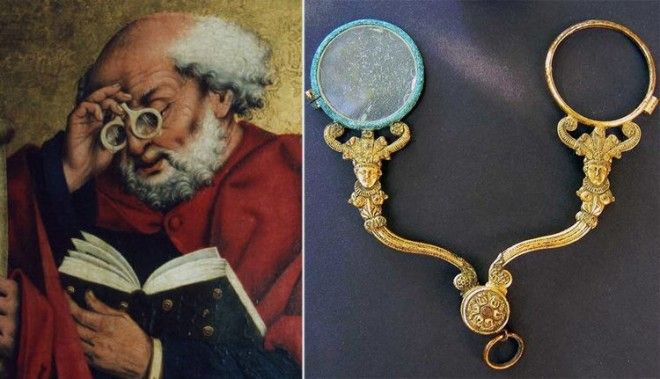
The first mentions of reading aids or reading stones date back to the Greek and Roman times. One such mention is Emperor Nero’s use of emerald. During the early 13th century, English scholar and Bishop of Lincoln Robert Grosseteste wrote of using optics for reading small letters in his treatise De iride (“On the Rainbow“), and in 1262, philosopher and friar Roger Bacon wrote of magnifying properties of lenses. It was in 1290 that the first corrective eyeglasses were made in northern Italy. Independently, the Chinese used flat panes of smoky quartz as “sunglasses” in the 12th century and the Inuit were already using snow goggles.
In his 1508 Codex of the eye, Manual D, Leonardo da Vinci introduced the idea of contact lenses in which he described a method of changing eye power by submerging the face in a bowl of water or by wearing glass hemispheres filled with water. The idea, however, was impossible to implement at that time. Though Descartes and Thomas Young tried implementing da Vinci’s idea, it wasn’t until 1888 that German ophthalmologist Adolf Gaston Eugen Fick constructed the first successful lens from a heavy blown glass. The lenses rested on the less sensitive tissue around the cornea and the space between them was filled with a dextrose solution.
4. The middle finger gesture has been used since 4th century BCE by ancient Greeks and Romans as an insult.

In Greek, the gesture is called “katapygon” and in ancient Greek comedy was used to insult another person by implying that they were “a man or a woman who submits to anal penetration.” The gesture can be found Aristophanes’s comedies The Clouds in 423 BCE and Peace in 421 BCE. A famous anecdote by Greek biographer Diogenes Laertius tells of the philosopher and co-founder of cynicism, Diogenes, directing the gesture at the orator Demosthenes in 4th century BCE Athens and calling him a demagogue. In modern times, the usage was traced back to the 1890s in the US by linguist Jesse Sheidlower, which anthropologist Desmond Morris believes probably came with the Italian immigrants.
5. The spring-loaded mousetrap first appeared in 1884 and is still the most effective and inexpensive way to eliminate mice in your house.

The first historical reference to mousetraps can be found in Emblemata by Andrea Alcaiato from 1534. Though there have been several other mentions of mousetraps during 17th and 18th century, it was in 1884 that the conventional mousetrap with a spring-loaded snap mechanism first appeared. Before the mechanical trap, the mice were caught by professional rat-catchers.
6. The earliest hints of smallpox vaccine date back to 10th century in China and the first successful smallpox inoculation was done in 1796.
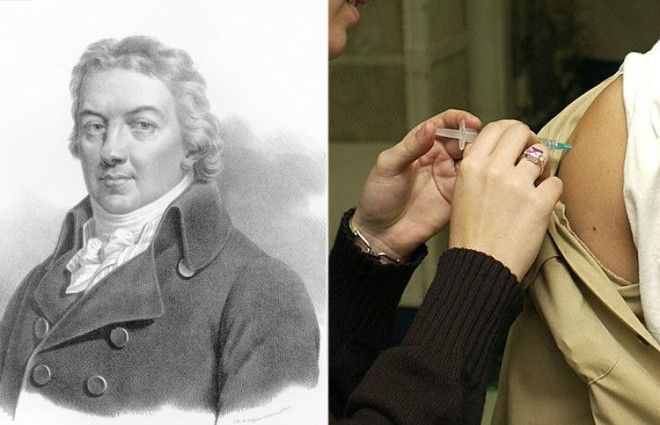
The Chinese documented a practice known as “nasal insufflation” in which powdered smallpox material, usually made from smallpox scabs, is blown up the nostrils to prevent smallpox. Various insufflation techniques were recorded in China between the 15th and 17th century. Reports of these techniques were received at the Royal Society in London in 1700 by Dr. Martin Lister from an employee of East India Company working in China and by Clopton Havers.
In the 1760s, Edward Jenner who was an apprentice surgeon heard about dairy workers in rural areas not being affected by disfiguring and often fatal smallpox because they already had cowpox. Cowpox is often transferred to dairymaids who touched the udders of the cows they were milking, but it only had mild effects in humans. So, in 1796, Jenner took the pus from the arms of a milkmaid with cowpox and rubbed it into the arm of an 8-year-old boy. Six weeks later, he introduced the boy to a small dose of smallpox and found that he did not catch it.
Jenner did further research and by 1798 reported that his vaccine was safe for both children and adults. By 1840, since vaccination with cowpox was much safer than smallpox inoculation, which was still practiced in England, smallpox vaccination was banned.
7. 3D printing was first invented in 1981, but it wasn’t until the 2010s that small companies could introduce more affordable and less industrial printers to the general public.Advertising
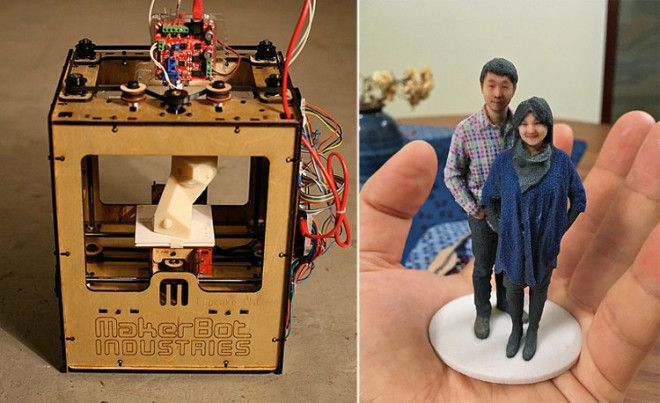
Additive manufacturing or printing, also known as “3D printing,” is a technique in which an object is “printed” by gradually laying or adding material and then fusing it. Hideo Kodama of Nagoya Municipal Industrial Research Institute first invented two methods for additive printing of 3D plastic models using a photo-hardening thermoset polymer in 1981. Two other methods of stereolithography, the process in which chains of polymers form links upon exposure to light, were patented independently in both the US and France in 1984.
Several other techniques and printers were invented and patented in the following years by various universities and industries. 3D printing became widely used at the industrial level making the creation of quick prototypes before mass production a norm. It was also used for manufacturing custom parts such as engine brackets and nuts that were otherwise made from metal bars or plates.
The potential of 3D printing was speculated by many writers and social commentators since the 1950s. Though the technology was used industrially for decades, patents and copyrights prevented any use of it by the public. During the early 2010s, places of higher education became a major buyer of desktop and professional 3D printers and libraries started using smaller printers for educational use. The recent demand for an affordable 3D printer for home use by DIY and Maker culture enthusiasts has encouraged several companies and projects to develop them.
8. The fax machine was first patented in 1843 and built in 1846.
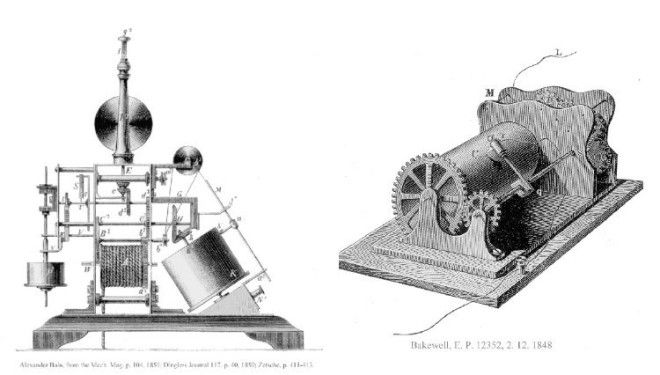
Alexander Bain, a Scottish inventor, received a patent for chemical, mechanical fax-type devices on May 27, 1843. In 1846, he was able to successfully reproduce his designs in laboratory experiments to which Frederick Bakewell made several improvements. In 1865, Italian physicist Giovanni Caselli, who also invented the Pantelegraph, introduced the first commercial telefax service between Paris and Lyon 11 years before the invention of the telephone.
In 1880, English inventor Shelford Bidwell constructed the “scanning phototelegraph,” the first telefax machine that could scan using selenium photocells. American engineer Elisha Grey further developed the fax machine in 1888 to let users send signatures over long distances allowing verification of identification or ownership. Scientists at AT&T managed to send 15 photographs suitable for newspaper reproduction from Cleveland to New York City on May 19, 1924, over the telephone, while previously they were sent over the radio.
9. The modern headphone jack was invented in 1878 and has only changed in size since then.
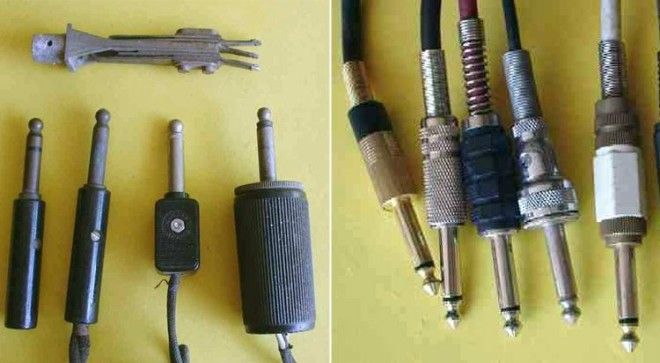
The audio jacks that we normally use come in three different sizes. The original 1/4 inch (6.35 mm) jack was created by George W. Coy back in 1878 and was used for the first commercial manual telephone exchange in New Haven, Connecticut. It is still used for mainstream musical equipment, especially the standard guitar models, making it the oldest jack still in use. The other two sizes of audio jacks, 1/8 inch (3.5 mm) and 3/32 inch (2.5 mm), were originally designed for earpieces of transistor radios in the 1950s and are still used as standard sizes. The 3.5 mm jack that is commonly used in today’s portable devices became popular in 1964 with the release of Sony’s radio and even more so with the release of Walkman in 1979.
10. The world’s oldest color film footage was shot by inventor Edward Raymond Turner way back in 1899.
In March 1899, Edward Raymond Turner, initially with the financial backing from cricketer Frederick Marshall Lee, began working in the workshop of color photography pioneer Frederic E. Ives. There he developed a camera which uses a rotating disk of three color filters to photograph color separations on one roll of black-and-white film. The image is recorded on three frames, one filtered by red, one by green, and one by blue. When the finished, film is then projected three frames at a time. There were, however, two drawbacks in his camera: recording an object in three different frames caused the image to blur if the object moved too fast, and mechanical instabilities caused the images to jitter. Before he could make any improvements, Turner died at the age of 30 of a heart attack. The research was passed on to George Albert Smith who created an entirely new process called “Kinemecolor” which used only red and green filters.

